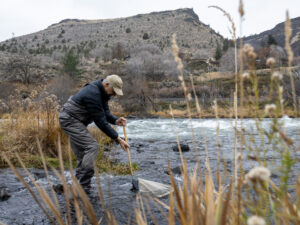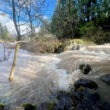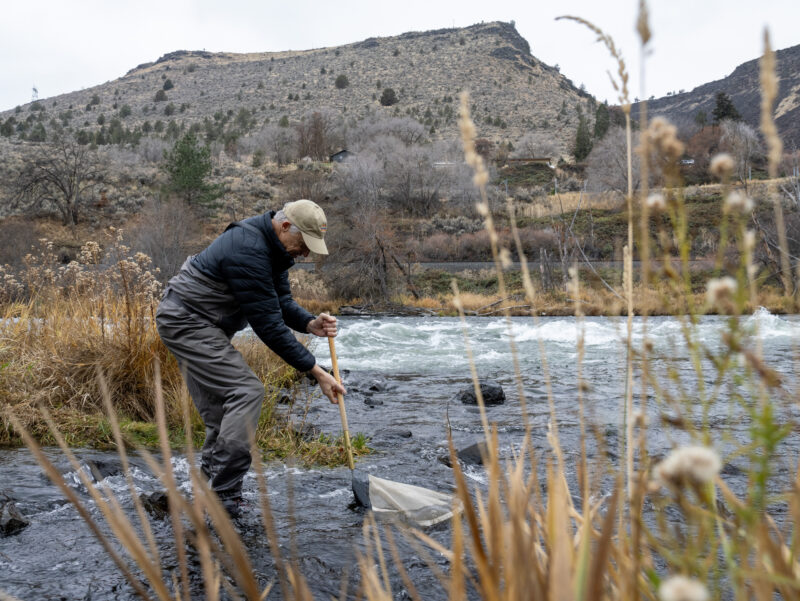A peer-reviewed paper says measures to mitigate harms from dams have “resulted in a net reduction in water quality and aquatic habitat.”
CAPTION FOR BOTH PHOTOS: Rick Hafele samples conditions in the Deschutes River near Maupin (Credit: Brian Burk)
BY NIGEL JAQUISS
Oregon Journalism Project
A new scientific review says the strategy that Portland General Electric and the Confederated Tribes of the Warm Springs developed to return fish to the upper Deschutes River isn’t working.
As OJP previously reported, there is significant disagreement between the utility and the tribe, which co-own the dams, on one side and river users and conservation groups on the other, over a device called a “selective water withdrawal tower” that PGE installed more than 15 years ago in a reservoir on the Deschutes River near Madras.

— Brian Burk
A new paper in the journal Water wades into the debate. Its three authors, led by Joseph Eilers, who has been conducting aquatic studies for PGE and other utilities for more than 30 years, say the tower is not restoring populations of fish like salmon and steelhead that hatch in freshwater, swim to the ocean, then return to where they hatched to reproduce. (Such fish are known as “anadromous fish.”)
“The expected increase in anadromous fish returns, the primary objective for installing the [selective water withdrawal tower], has not been realized,” the paper says.
In 2008, PGE and the Warm Springs announced the $108 million tower would “restore fish passage” around the Pelton Round Butte hydroelectric complex on the Deschutes by “providing healthier conditions for the fish; modify the temperature of the lower Deschutes River to more closely match what it was before the dams were constructed; and improve the water quality in the reservoirs and in the river.”
The tower creates a current in Lake Billy Chinook, the reservoir created by construction of the Round Butte dam in 1965. That current is supposed to attract juvenile fish so they can be collected and moved around the dam and released downstream. The tower also mixes cooler, cleaner water from the bottom of the reservoir with warmer water near the surface to create downstream water quality similar to that on the Deschutes before the dams went into operation six decades ago. Prior to the installation of the tower, the dam released only cooler water from the bottom of the reservoir.
But 15 years after the tower went live, the new assessment says, it isn’t working.
The paper, written by Eilers, Tim Nightengale and Kellie B. Vache, notes that PGE and the Warm Springs paid for the data collection for the authors’ work. In other words, the authors are reporting results unlikely to please the dams’ owners—lending greater significance to their findings.
“We conclude that the installation and operation of the selective water withdrawal at Round Butte Dam has resulted in a net reduction in water quality and aquatic habitat in the lower Deschutes River,” the authors write.
In addition to noting that the tower doesn’t function as originally designed—it can only release a maximum of 60% cooler, cleaner water from the bottom of the dam rather than 100%—the paper takes aim at why the tower might not be working as its owners hoped and points out some probable consequences.
“The assumption guiding the installation of the [selective water withdrawal tower] was that replicating a warmer spring pre-dam water temperature regime would provide more favorable conditions for anadromous fish to spawn and for their eggs to incubate,” the paper says. “However…there are several major reservoirs upstream of the project that store spring runoff for irrigation of cropland.…The diversion of these cold, springtime flows for agricultural irrigation has likely caused an increase in water temperature in the upper Deschutes River and Crooked River.”
The result, the authors found, is that the water released to the lower Deschutes is warmer and contains more agricultural runoff than PGE anticipated. One consequence: The authors noted that small-mouth bass, a nonnative, warm-water predator, appears to be far more common in the Deschutes.
“Warm-water fish species now frequent the lower third of the river during the summer, an indication that the river is warmer, perhaps even warmer than experienced during the pre-dam period,” the paper says.
The new analysis comes amid continuing disagreement between the utility and the tribe, which remain positive about the tower’s operation, and users of the 100 miles of the Deschutes below the Pelton Round Butte dams, who believe the tower has harmed fishing in the lower river and want more cold, clean water to be released from the dam.
PGE says it has regularly adjusted how it manages flows to create the best conditions for the river. The utility and the tribes contend that anglers want the water colder than is natural in order to benefit sport fishermen, rather than bring the river to optimal health.
Seven conservation groups and Gov. Tina Kotek asked the Oregon Department of Environmental Quality earlier this year to ensure that PGE and the Warm Springs are operating the dams in the manner that is best for the health of the Deschutes.
“We are asking [DEQ] for a renewed examination of all available options for meeting Deschutes water quality standards and the Pelton Round Butte fish passage objectives,” Kotek’s natural resources adviser wrote to the agency in February. DEQ has said it expects to finish an initial review this fall.
PGE and the Warm Springs, on whose reservation part of the dam complex sits, co-own the Pelton Round Butte complex (the tribe owns 49.9%). PGE buys all the electricity generated by the dams, which is enough to power about 150,000 homes. It paid the tribe $47.3 million for that energy in 2023 and $37.2 million in 2024, according to the utility’s federal filings.
PGE spokesman John Farmer says the utility disagrees with the new paper’s findings.
“The selective water withdrawal wasn’t built to re-create 1950s river temperatures—it was designed to remove the dam’s influence on downstream temperatures under today’s conditions. For 40 years prior to the SWW, there were no anadromous fish in the upper basin; now there are. There are also significant gains in fall Chinook, the largest and most abundant run in the Deschutes. That is progress,” Farmer says. “Our priority is to mitigate the impacts of the hydro project—not to undo every upstream impact that has shaped this river since the 1800s.”
PGE takes issue with the paper’s omission of increases in fall Chinook, which saw a post-tower record return in the past year, and says its authors relied in part on old data, Farmer adds. “The [selective water withdrawal tower] has delivered real biological benefits, and monitoring shows the Deschutes is supporting strong fish runs.”
Through a spokesman, the Warm Springs declined to comment.
“It is evident from the predetermined line of questions that the Oregon Journalism Project isn’t coming to the Confederated Tribes of Warm Springs to ‘give communities a voice,’ as your mission states,” said Dennis White III, chairman of the Confederated Tribes of Warm Springs Tribal Council. “We will only consider participating in your story requests when your team displays interest in understanding our contributions to the Deschutes River Basin since time immemorial, and therefore the full context of our decadeslong efforts to restore salmon populations that, not long ago, were a breath away from extinction.”
Rick Hafele, a board member at the Deschutes River Alliance, and a former DEQ water scientist who has fished and studied the lower Deschutes for 50 years, says the new study is particularly significant because its lead author, Dr. Joseph Eilers of Bend, previously prepared a comprehensive analysis of the Deschutes for PGE and the Warm Springs and is a leading expert on the river.
“It’s an important independent assessment that has concluded the operations of the selective water withdrawal tower are harming the lower Deschutes River,” Hafele says. “This should mean something to DEQ as it evaluates the situation. I know people at the agency have read it.”





